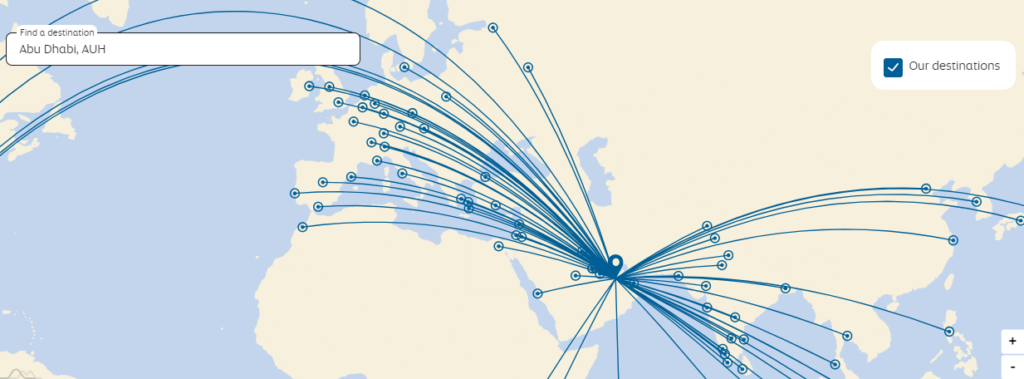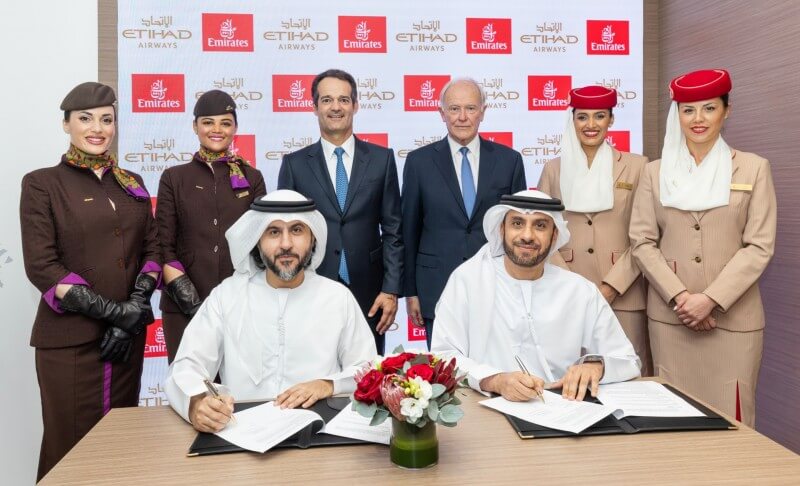Introduction
Etihad Airways, Abu Dhabi’s main airline courier and UAE’s national airline is managed by the Abu Dhabi Sovereign Fund, the biggest wealth fund in the world, managing a capital of more than $1.7 trillion.
With such a backing, it’s no surprise that Etihad would challenge some of the big boys such as Emirates and Qatar Airways.
The question is, why haven’t they reached the top or become a household name like their Middle Eastern competitors, despite the backing of oil-rich Abu Dhabi and the Sovereign Fund?
First, it’s important to note that Etihad was started 18 years after Emirates and 10 years after Qatar Airways. Emirates was founded in 1985, Qatar in 1994 and Etihad in 2003.
This gave Emirates and Qatar Airways a significant head start, allowing them to establish routes, build customer loyalty, and forge strong relationships with key industry stakeholders.
Related: UAE Based Airlines
A New Vision and Plan
Abu Dhabi, the capital of the United Arab Emirates, holds the country’s largest oil reserves (96%). However, with oil being a finite resource and the world shifting toward greener economies, reducing reliance on oil is essential.
Tourism offers a valuable opportunity to diversify the Emirate’s economy and contribute more to its GDP.
Etihad Airways is also playing a key role in attracting visitors by partnering with major attractions like Warner Bros. World™ Yas Island. Through this partnership, Etihad has introduced a dedicated, branded children’s lounge at Zayed International Airport, enhancing the travel experience for families.
Competition in the aviation industry is intensifying. Airlines like AirAsia, Air Arabia, and Air India are offering competitive fares and promoting transit travel through their cities. Additionally, Saudi Arabia’s new airline, Riyadh Air, is set to launch commercial flights in 2025, adding more competition to the market.
Routes & Fleets

Etihad Airlines has about 120 destinations that it flies to. Emirates has about 160 destinations while Qatar Airways is the leader here with 170 destinations.
When it comes to its fleet, Etihad has 4 A380s, 5 A350s, 29 A320s, 43 787s, and 9 777s.
Alliance with Emirates

Both Emirates and Etihad have one major common goal, to bring as many tourists to UAE as possible. The two hope that travelers can experience more than one destination in a single trip.
With this, in May of 2023, both airlines entered into an agreement that offers travelers more flexible travel options and promotes tourism in the country. The partnership allows:
- Single-ticket purchases for flights arriving in Dubai and departing from Abu Dhabi, or vice versa.
- Open-jaw ticketing, where passengers can fly into one city and leave from another.
- Codeshare flights with reciprocal frequent flyer benefits between the two airlines.
- Joint efforts to market the UAE as a regional tourism destination.
This collaboration between the UAE’s two major airlines aims to enhance the travel experience and support the country’s tourism industry, aligning with the UAE’s economic diversification goals.
Some of the things Etihad is doing to increase its growth and footprint
- Abu Dhabi stop over program.
Abu Dhabi relaunched the stop over program which is exclusive to Etihad Airways and has seen an increase of 242%. In the last half of 2023, the program welcomed 7,000 visitors compared to 24,000 visitors in the first half of 2024.
Such initiatives will push tourists to consider using Etihad Airways so as to have a tour of Abu Dhabi and take advantage of the stop over program. - Improving the Zayed International Airport
This airport got this new name in February of this year, changing from Abu Dhabi International Airport. That was not the only change as the airport got a new Terminal, Terminal A. Passengers at Terminal A can enjoy a hassle-free journey from pre-travel to boarding, thanks to cutting-edge technologies and integrated biometric systems. The terminal offers self-service kiosks, efficient security screening, and modern baggage handling systems, all designed to create a seamless and fully digital travel experience.
Also, Zayed International Airport aims at being the first paperless airport. - Introduction of new routes
Etihad has introduced about 6 new routes and resumed flying to Nairobi recently. In total, Etihad flies to about 120 destinations. - Codeshare partnerships
The airline has partnered with Batik Air Malaysia to enhance connectivity between UAE and Malaysia. This will allow a seamless connection between Abu Dhabi and five key locations in Malaysia, including the idyllic island of Langkawi, the culturally and culinary rich city of Penang, and Kota Kinabalu
Conclusion
Will Etihad be able to lure passengers away from Emirates & Qatar Airways?
We will have to wait and see. What we know for sure is that Etihad is putting up a fight. Whether they will surpass these two giants is for us to wait and see.




